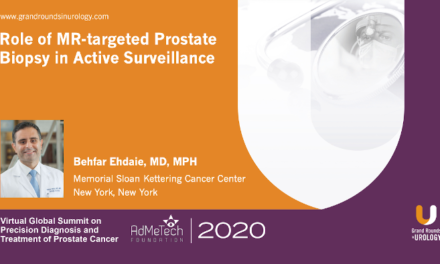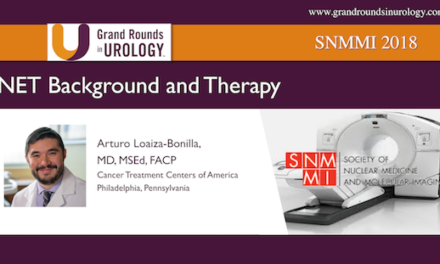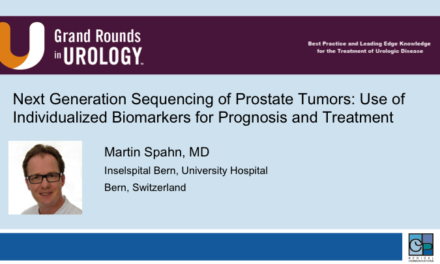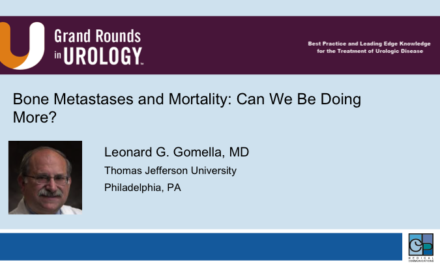Dr. Gomella presented at the 26th International Prostate Cancer Update on Friday, January 22, 2016 on “Intermittent Therapy: When To Start, or Restart, and the Role of Imaging.”
Keywords: prostate cancer, intermittent therapy, androgen deprivation, PSA
How to cite: Gomella, Leonard. “Intermittent Therapy: When To Start, or Restart, and the Role of Imaging” Grand Rounds in Urology. January 22, 2016. Nov 2024. https://dev.grandroundsinurology.com/prostate-cancer-leonard-gomella-intermittent-therapy-when-to start-or restart-and-role-of-imaging/.
Transcript
Intermittent Therapy: When To Start, or Restart, and the Role of Imaging
We’re going to talk about the role of intermittent therapy. And it’s somewhat controversial but I hope to convince you maybe by the end of the talk it’s not as controversial as a lot of people may think today.
So I think everyone is well aware of why intermittent androgen suppression has been supported or suggested for a long time. We know there are many adverse events associated with androgen deprivation therapy. We had some very nice translational basic science talks about this over last couple days. And intermittent androgen therapy, intermittent deprivation, IHT whatever term you like to use is mainly meant to minimize the side effects of the quality of life and possibly delay the development of hormone resistance. So the concept everyone knows as cyclical androgen deprivation therapy. You’re on treatment for a fixed period of time 6 to 9 months depending on which protocol you like to use. And then you come off treatment and when your PSA reaches a certain predefined level you go ahead and then restart the intermittent hormone therapy. So very interesting from one of our talks earlier today that the neuroendocrine markers with IHT versus continuous appear to be actually improved with intermittent hormonal therapy. Intermittent hormone therapy appears to delay or impact on the development of neuroendocrine disease. But we have a lot of other rationales why it works. The original work was done in fact in a rat mammary tumor model but now we’ve seen over the last 25 years innumerable clinical trials that have gone ahead to work with intermittent hormonal therapy.
One of the biggest things reported is actually significant cost savings. So this just shows little graphic what happens is the goal is to try to encourage the prostate cells to like to grow in an androgen rich environment as opposed to growing in the androgen poor environment that may cause the development of more androgen insensitive cells. So where we been with intermittent hormonal therapy over the years and I just want to give a brief synopsis of the very good basic data and that will finish up on the most modern studies that we have.
So the early reports going back to the late 80s and early 90s basically showed that there was a very strong suggestion that men would have an improved quality of life on intermittent hormonal therapy. The treatment protocols at the time were very variable the actual number of cases that were reported by Dr. Klotz they go back to the early 1990s. This concept was really brought forward by our Canadian colleagues was relatively small. But clearly there was something going on there was some signal that intermittent hormonal therapy may work. When you look at a Phase 2 trials conducted through 2009 it was showing the fairly good acceptance of both clinicians and patients. Toxicity was clearly reduced and I think that’s really the Holy Grail that a lot of people really latched onto and it did not appear in the Phase 2 trials to negatively impact on overall survival.
So the studies showed a few interesting things that there are a wide range of patients used in the early studies from localized disease to why the metastatic disease. Although most of the patients recover their testosterone there were only is still about 20 to 30% of patients who did not recover their testosterone. The cycle lengths were all over the place sometimes one or two cycles, sometimes as many as 12 cycles, but there would appear to be a positive signal again on the impact of castration, delaying castration resistance. Few other things were picked up in these early trials. One of them was that through each cycle that you went on intermittent hormonal therapy, the time that the cycle before you reinstituted, hormonal therapy was shortened. And you can see here for most of the early studies that all by the time most of these patients got the cycle six that the time that they were off therapy was significantly reduced.
Recovery of testosterone was concerning in many studies. This one from Dr. Paradenson from a European Urology basically showed that factors delaying androgen recovery in men coming off the cycle included older men and men that were coming in with lower baseline testosterone and those that were on androgen deprivation therapy longer. So again, clearly not all men have a good recovery of testosterone after the long-term use of intermittent therapy. However there’s no question that the tolerability and quality of life was improved. Hot flashes were really significantly impacted in a lot of men who actually had a much better sense of being when they were back off of the hormone therapy and began to normalize their testosterone. And again one of the important signals that came up was improved in sexual activity. Many men were able to report a return of sexual functioning. Adverse quality of life in virtually all of these studies were shown looking at physical, cognitive, emotional, social, sexual all showed improvement in aggregate studies in the early experience with intermittent therapy. And sexual activity again there was no question that it was better in these early studies to have a comparison of improved sexual activity in men who are on intermittent hormonal therapy.
So who had been traditionally considered for intermittent hormonal therapy and patients who initially had to respond to androgen deprivation therapy with a decline of PSA to a certain predefined level. And this the important thing not all patients who are put on hormone therapy for advanced disease are going to be good players. And it basically tells us that if someone gets an initial response of a PSA of less than 4 after the cycle of intermittent of hormone therapy, they’re probably a good candidate. For patients who’ve already been treated after radiation therapy or surgery who are going on in intermittent hormonal therapy you probably want to see that initial cycle go less than 0.5 ng per ml. When you restart the androgen deprivation therapy again all thresholds were kind of randomly chosen 6 to 15, 10 to 20. In the a PR7 trial that will talk about you restarted the therapy when they a were these therapy was started. When the PSA rose to greater than 3 and the other studies with the PSA relapse after radiation therapy greater than 6 to 10. And we’ll talk a little bit how this is been refined in the last couple slides.
So basically there was an international consensus study on the use of intermittent hormonal therapy that was published back in 2007. And basically showed that intermittent therapy was viable and that Phase 3 trials really needed to be done because almost everything we talked about so far was the early Phase 1 and Phase 2 trials. Evan Yu published a paper looking at some prognostic data for castration resistance and basically was able to show that men treated on a trial of intermittent androgen deprivation that the duration of the first off treatment interval was prognostic. In other words, the longer patients were off the treatment and the PSA came back up, the better their prognosis was. Again prognostication is going to become very important when we look at the final recommendations that have recently come out from several large groups about the use of intermittent hormonal therapy.
So then we move into the Phase 3 trials and we all know that this is where the money is and they were really three major intermittent hormonal therapy trials if you look at the numbers 1300, 700 and 1500. And we will talk about each one of these trials and this is kind of where the money is and we’re a little bit more of the controversy actually came in with intermittent therapy. So the South European urologic oncology group Phase 3 study looked at about 600 patients and basically their results showed that using intermittent versus continuous there was no difference in overall survival. They showed these survival curves looking at both M0 patients and M1 patients and although was again a little bit of a suggestion for the M positive metastatic patients slightly improved increased survival. None of this was statistically significant.
This paper got a lot of attention and a lot of secondary and tertiary analysis the PR7 trial from the NCIC in Canada that swab RTOG and also was put up on the CTSU. This looked at intermittent versus continuous androgen suppression in the patients who had PSA progression after radical local therapy. You could have had previous monotherapy radiation or salvage radiation and basically the trigger to get on the trial what you had to have was a PSA that was going up to greater than 3. You had to have a reasonably normal testosterone 145 ng/dL. No matter, no metastatic disease and you could’ve had adjuvant neoadjuvant therapy beforehand. And the way the PR7 trial worked is that PSA and testosterone were checked every two months and when the PSA hit 10 you were put back on the eight months of androgen deprivation therapy. And again here you see no difference in overall survival in the intermittent versus the continuous androgen deprivation group. Time to castration resistance likewise there was a slight suggestion it was delayed with intermittent androgen suppression. And the disease specific mortality if you look at death related to disease and death not related to disease there was a sort of a flip-flop, and you’ll see that what I mean by that the minute.
The conclusion was that from the PR7 it was not inferior and the flip-flop was there were 9% more prostate cancer deaths on the intermittent therapy arm. However, that was balanced out by the adverse impact of the negative impact probably cardiovascular on the patients who had continuous hormonal therapy. So based on this paper intermittent hormonal therapy was to get considered recommended to be the standard of care for patients with a PSA recurrence following radiation therapy either primary or salvage. This was the SWOG study headed up by Maha Hussein that was again run by a multiple groups looking at patients with metastatic prostate cancer. And the SWOG 9346 look at newly diagnosed hormone sensitive patients that have reasonably good performance status. The PSA had to greater than five they were placed on hormone therapy for seven months. If you achieved a Nader of less than 4 you when on intermittent therapy and if you did not achieve the Nader it was continued. And the endpoints were to look at the non-inferiority of intermittent versus continuous.
So again the study showed that continuous versus intermittent was not inferior to continuous. There was very strong data and this is one of those parameters I think it is now gotten into the NCCN guidelines. That is if you bottom out your PSA to less than basically undetectable or 0.2 you have the best long-term survival. Whereas if you don’t Nader out and you don’t come down to less than 4 you probably should stay on continuous hormone therapy. It’s not a good prognostic sign for the use of intermittent therapy. Median survival was very impressive if you got your PSA of, down to less than 4 you had a 44 month survival advantage if it went less than 0.2 undetectable, that survival advantage went up to 75 months.
Lastly it is something known as bipolar therapy. This was published last year by the group at Hopkins, kind of a quasi-twist on intermittent therapy we’re actually give patients testosterone replacement and then treat them with chemotherapy. So this is called back therapy or bipolar androgen therapy. Essentially it’s a cruel twist on intermittent therapy but something to to keep an eye on. Dave wanted to talk about imaging. There’s really not a lot in the literature right now about imaging with intermittent hormonal therapy. This is sort of a very well cited work that the that David headed up a looking at the radar group trying to identify patients with the earliest evidence of metastatic disease. But we don’t have a lot right now for this and intermittent hormonal therapy.
So what we learned about IHT? We have level one evidence that supports oncologic equivalents. We have improved quality of life and fewer side effects and patient selection for IT is important to make sure you get the good results that you expect to get. PR7 and SWOG 9346 both showed non-inferiority. Again a lot of these were the victim of statisticians and how statistics are written. There was a very rigid mark in the SWOG trial make sure the really got a very strong signal with the statistics. And you can see here that the upper limit being above the predefined 90% upper limit of 1.2 for statistical significance. And that was not really reached, but the other benefits bone protection, protection against metabolic syndrome; decreases in treatment costs are real. And the bottom line where we today this paper was published two years ago in the Canadian Journal February 2014 it’s a nice roadmap and it gives you insight into the SWOG the PR7 and the European trial and it gives you a roadmap to decide if you want to use intermittent hormonal therapy. How she to best apply it?
And lastly we just had a major review published in 2015 that looked at over 6,800 patients all the major trials basically showed no difference in overall survival cancer specific survival or progression free survival. And this is just a forest plot you can see that individual papers may swing on either side of one, but basically when you add it all up and down line look at overall survival cancer specific survival there’s really no difference. 2012 the European Association of Urology was cool on intermittent therapy and now the EAU is very high and positive in IHT. They believe it’s not investigational anymore. If you look at ESMO there’s still a little bit mixed about the use of continuous versus intermittent. And this is the probably the biggest thing that happened the NCCN guidelines is now fully behind the use of intermittent hormonal therapy. And say that you can use it for both M1 and M0 disease stating it’s not inferior. However they noted that from the unplanned analysis of the PR7 trial that if got somebody with bad high-grade high Gleason score prostate cancer there probably better treated by continuous androgen ablation.
So the NCCN strategy for 2016, you hope to get people down the list and the PSA 0.2 if they don’t Nader out you should keep them on continuous androgen ablation. So the bottom line is the individual studies can be somewhat confusing you’ll see some that a little more positive or negative but clearly it’s an option after radiation failure and selected M1 patients. The use in M0’s a little bit less clear in a little bit more controversial we have absolutely no data what this means now in terms of the Charted and STAMPEDE trials and that something we’re going to have to look at. But there’s no question that there’s no difference in the overall survival and the quality of life in general’s improved in the in most of these.
ABOUT THE AUTHOR
Leonard Gomella, MD, FACS, is the Bernard W. Godwin, Jr., Professor of Prostate Cancer and Chairman of the Department of Urology at the Sidney Kimmel Medical College of Thomas Jefferson University. He joined the Jefferson faculty in 1988 and was appointed Chair in 2002. He serves as Senior Director for Clinical Affairs for the NCI-designated Sidney Kimmel Cancer Center, Clinical Director of the SKCC Network, and Urology Chair for NRG (RTOG). Dr. Gomella is involved in translational basic science and clinical research in the development of new diagnostic techniques and treatments for prostate and bladder cancer through the Sidney Kimmel Cancer Center as Co-Leader of the Biology of Prostate Cancer Program. In 1992, he led the team that first used molecular techniques to detect circulating tumor cells in prostate cancer. He has given over 500 presentations, written over 400 papers, and edited dozens of chapters and monographs in the field of urology. Dr. Gomella has authored and edited many editions of a number of books for medical students, residents, and practicing physicians, including the “Clinician’s Pocket Reference” (aka “The Scut Monkey Book”) and “Five Minute Urology Consult.” He is also Editor-in-Chief of the Canadian Journal of Urology. “Recovering from Prostate Cancer,” which Dr. Gomella wrote in 1993, was the first book released for the general public specifically on the topic of prostate cancer.
“Best Doctors in America,” “Top Doctors for Cancer,” and Philadelphia Magazine’s “Top Doctors” have recognized him for many years for his contributions to urologic oncology and prostate cancer care. He also received national recognition in Newsweek in 2015. In 2007, Men’s Health listed Dr. Gomella as one of the 20 top urologists in the US. He has received numerous awards, including the American Cancer Society’s “Volunteer Achievement Award” and an “NCI Achievement Award.” He has been President of the Mid-Atlantic Section of the AUA and has been elected to the American Association of Genitourinary Surgeons and the prestigious Clinical Society of Genitourinary Surgeons. The University of Kentucky College of Medicine awarded him a “Distinguished Alumnus Award” in 2009. From 2015-2017, he was President of the Society of Urologic Oncology. In 2015, he received a “Distinguished Contribution Award” from the AUA and Jefferson honored him with the “Jefferson Achievement Award in Medicine.”





